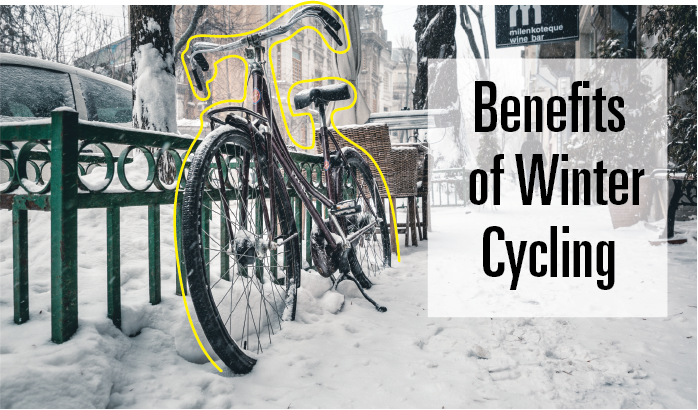The Benefits of Winter Cycling

As the weather cools and daylight shortens, people tend to put their bikes away for the winter season. Biking in the winter can seem unappealing or dangerous, however, with the right knowledge about safety about how to navigate winter riding, biking in the winter offers many benefits beyond getting you from point A to B. Let’s explore how winter biking may benefit you.
Combat the winter blues
The cold winters can keep us cooped inside and prevent us from getting a sufficient amount of vitamin D. Incorporating biking as a means of travel offers a way to embrace the outdoors and get fresh air and sunlight.
Save money
With the HSR student bus pass suspended this year due to online schooling, relying on bussing without the pass can be expensive. However, biking is a more affordable, sustainable way to cut down on transportation fees and make use of gear that you likely have on hand at home!
Solo commute
If you’re trying to minimize interactions or feel more comfortable avoiding crowds during COVID-19, biking may be a viable option for you.
Although biking in the winter requires additional safety precautions due to weather hazards, it is easy to adapt to the changing seasons as long as you prepare yourself. Once you master the routine of safe cycling, you will be able to build your cycling confidence. Below are safety precautions that should be taken before, during and after your cycle.
Stay warm and bright
There’s nothing worse than feeling cold and uncomfortable on your commute, so make sure you dress for the weather. Start with a base layer that will keep your body insulated, followed by water resistance outerwear, head coverage, biking gloves and a helmet. Wearing bright colours is also important for ensuring that you are visible to other road users, especially when cycling when it’s dark outside.
As you’re warming up to and gaining confidence with winter cycling, consider going out when the weather isn’t extremely cold or wet to get to know what gear works best in the cooler weather.
Avoid the curbs
As the snow begins to accumulate towards the shoulder of the road, it adds a hidden risk to cyclists as the snow melts and freezes over quickly, making it extremely slippery. It is recommended that cyclists stay away from the shoulder of the road and bike in the central lane if possible.
Proper bicycle maintenance
There are a couple of elements that are necessary to keep your bike road-ready. Start by lowering your tire pressure during the winter months so that your tires are more squared to the ground and get more traction. You can reference this article about how to reduce tire pressure, as all tires require a different amount of air or Pound-Force per Square Inch (PSI). You can find the tire pressure range on the edge of the tire close to the spokes.
In Ontario, you must have a white front light and a red rear light or reflector if you ride between 1/2 hour before sunset and 1/2 hour after sunrise. In addition, wearing a helmet is an important preventative accessory that protects you from collisions, slips or falls. Lastly, if your bike does not already have fenders, you may consider getting some as they stop any splash up of rain or snow.
Taking care of your bike after every ride is exceptionally important during the winter months as it can quickly accumulate dirt and debris. Consider using this in-depth tutorial on how to keep your bike clean in 7 steps. Removing snow and salt from your bike after every ride will keep it running well during the season and avoid rusting.
Developing Confidence as a cyclist
If you are new to biking, there are a few ways to boost your confidence before or while you are on the road. Make sure to map out your cycling route first, and ensure you know which directions to take as this eases the added stress of getting lost! Bike lanes are usually cleared of snow, similar to roads, so these are a safe option for riding all year. Additionally, ask a friend who bikes or wants to learn to join along, this can be a great way to socialize while maintaining a safe physical distance. Lastly, ensure you bring your cellphone on your cycle as an added safety precaution.
Despite the common assumption that cycling is only safe while the weather is warm and dry, biking offers many benefits in the winter. Your cycling confidence won’t develop automatically, but with more experience and understanding of bike mechanics, you can prepare yourself for safe cycling this winter and feel confident while doing so.
By: Rachel Lieske
Physical Activity, Physical Health